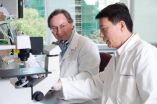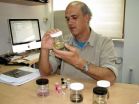Novel type 1 diabetes treatment shown to work on human beta cells transplanted into mice
Chemical produced in pancreas that prevented and reversed Type 1 diabetes in mice had the same effect on human beta cells transplanted into mice
2014-11-25
(Press-News.org) TORONTO, Nov. 29, 2014--A chemical produced in the pancreas that prevented and even reversed Type 1 diabetes in mice had the same effect on human beta cells transplanted into mice, new research has found.
GABA, or gamma-aminobutryic acid, is an amino acid produced by the same beta cells that make and secrete insulin.
Drs. Gerald Prud'homme and Qinghua Wang of the Keenan Research Centre for Biomedical Sciences of St. Michael's Hospital published a paper in 2011 showing for the first time that GABA injections not only prevented Type 1 diabetes in mice, but even reversed the disease.
A new paper published (Nov. 29) in the December issue of Diabetes shows GABA does the same thing in mice who have been injected with human pancreatic cells.
Type 1 diabetes, formerly known as juvenile diabetes, is characterized by the immune system's destruction of the beta cells in the pancreas. As a result, the body makes little or no insulin. The only conventional treatment for Type 1 diabetes is insulin injection, but insulin is not a cure as it does not prevent or reverse the loss of beta cells.
Drs. Prud'homme and Wang also found that GABA vastly improved the survival rate of pancreatic cells when they were being transplanted into mice. About 70 per cent of pancreatic cells die between the time the organ is harvested and transplanted. The researchers said their finding could lead to future research specifically related to pancreatic transplants.
GABA has been known for decades to be a key neurotransmitter in the brain, a chemical that nerve cells use to communicate with each other, but its role in the pancreas was unknown until the 2011 paper by Drs. Prud'homme and Wang.
GABA and related therapies would have to be tested in human clinical trials, a process that could take several years, the researchers said, noting that many treatments that work in mice do not always translate into effective human therapies.
INFORMATION:
This study received funding from the Juvenile Diabetes Research Foundation and the Canadian Institutes for Health Research.
About St. Michael's Hospital
St. Michael's Hospital provides compassionate care to all who enter its doors. The hospital also provides outstanding medical education to future health care professionals in more than 23 academic disciplines. Critical care and trauma, heart disease, neurosurgery, diabetes, cancer care, and care of the homeless are among the Hospital's recognized areas of expertise. Through the Keenan Research Centre and the Li Ka Shing International Healthcare Education Centre, which make up the Li Ka Shing Knowledge Institute, research and education at St. Michael's Hospital are recognized and make an impact around the world. Founded in 1892, the hospital is fully affiliated with the University of Toronto.
For more information, or to speak to Drs. Prud'homme or Wang, please contact Leslie Shepherd, Manager of Media Strategy.
Inspired Care. Inspiring Science.
http://www.stmichaelshospital.com
Follow us on Twitter: http://www.twitter.com/stmikeshospital
[Attachments] See images for this press release:

ELSE PRESS RELEASES FROM THIS DATE:
2014-11-25
LIVERMORE, Calif. - Nanoporous metals -- foam-like materials that have some degree of air vacuum in their structure -- have a wide range of applications because of their superior qualities.
They posses a high surface area for better electron transfer, which can lead to the improved performance of an electrode in an electric double capacitor or battery. Nanoporous metals offer an increased number of available sites for the adsorption of analytes, a highly desirable feature for sensors.
Lawrence Livermore National Laboratory (LLNL) and the Swiss Federal Institute of ...
2014-11-25
WACO, Texas (Nov. 25, 2014) - Note to venture capitalists: Entrepreneurs are watching to see if you're naughty or nice.
A recently published study of more than 550 decisions and responses from 144 experienced entrepreneurs reveals that "knowledge of explicit ethical or unethical behavior (by venture capitalists) profoundly shapes the entrepreneurs' willingness to partner."
Baylor University researcher Matthew S. Wood, Ph.D., assistant professor of entrepreneurship in Baylor's Hankamer School of Business, co-authored the study, "Take the money or run? Investors' ethical ...
2014-11-25
A measles vaccine made of fine dry powder and delivered with a puff of air triggered no adverse side effects in early human testing and it is likely effective, according to a paper to be published November 28 in the journal Vaccine. The paper is now available online.
In 2013, measles killed 145,700 people, most of them children, according to the World Health Organization. That's despite the fact that the conventional injectable vaccine against the measles virus is effective.
"Delivering vaccines in the conventional way, with needle injections, poses some serious challenges, ...
2014-11-25
Treatment for obstructive sleep apnea with continuous positive airway pressure (CPAP) or mandibular advancement devices (MADs) can lead to modest improvements in depressive symptoms, according to a study published by Marcus Povitz, Carmelle Bolo, and colleagues from University of Calgary, Canada, in this week's PLOS Medicine.
The researchers identified 22 randomized controlled trials that investigated the effects of CPAP or MAD treatment on patients with obstructive sleep apnea and that measured depressive symptoms before and after treatment. By pooling the results from ...
2014-11-25
HOUSTON - (Nov. 25, 2014) - An international collaboration of scientists including Baylor College of Medicine has completed the first genome sequence of a myriapod, Strigamia maritima - a member of a group venomous centipedes that care for their eggs - and uncovered new clues about their biological evolution and unique absence of vision and circadian rhythm.
Over 100 researchers from 12 countries completed the project. They published their work online today in the journal PLOS Biology.
"This is the first myriapod and the last of the four classes of arthropods to have ...
2014-11-25
The arthropods are one of Earth's real success stories, with more species of arthropod than in any other animal phylum, but our knowledge of arthropod genomes has been heavily skewed towards the insects. Recent work has furnished us with the genome sequences of an arachnid and a crustacean, but the myriapods (centipedes and millipedes) have remained the one class of arthropods whose genomes are still in the dark.
An international team of scientists (over 100 from 15 countries) with Stephen Richards (Baylor College of Medicine) as senior author has now sequenced the genome ...
2014-11-25
Centipedes, those many-legged creatures that startle us in our homes and gardens, have been genetically sequenced for the first time. In a new study in the journal PLoS Biology, an international team of over 100 scientists today reveals how this humble arthropod's DNA gave them new insight into how life developed on our planet.
Centipedes are members of the arthropods, a group with numerous species including insects, spiders and other animals. Until now, the only class of arthropods not represented by a sequenced genome was the myriapods, which include centipedes and ...
2014-11-25
Learning-related brain activity in Parkinson's patients improves as much in response to a placebo treatment as to real medication, according to a new study by researchers at the University of Colorado Boulder and Columbia University.
Past research has shown that while Parkinson's disease is a neurological reality, the brain systems involved may also be affected by a patient's expectations about treatment. The new study, published in the journal Nature Neuroscience, explains how the placebo treatment -- when patients believe they have received medication when they have ...
2014-11-25
Endangered Snake River sockeye salmon are regaining the fitness of their wild ancestors, with naturally spawned juvenile sockeye migrating to the ocean and returning as adults at a much higher rate than others released from hatcheries, according to a newly published analysis. The analysis indicates that the program to save the species has succeeded and is now shifting to rebuilding populations in the wild.
Biologists believe the increased return rate of sockeye spawned naturally by hatchery-produced parents is high enough for the species to eventually sustain itself in ...
2014-11-25
MAYWOOD, Il. - An award-winning study by a Loyola University Chicago Stritch School of Medicine researcher has documented how homeless, mentally ill women in India face a vicious cycle:
During psychotic episodes, they wander away from home, sometimes for long distances, and wind up in homeless shelters. They then are returned to their families before undergoing sufficient psychosocial rehabilitation to deal with their illness. Consequently, they suffer mental illness relapses and wind up homeless again.
"The study illustrates how there must be a balance between reintegrating ...
LAST 30 PRESS RELEASES:
[Press-News.org] Novel type 1 diabetes treatment shown to work on human beta cells transplanted into mice
Chemical produced in pancreas that prevented and reversed Type 1 diabetes in mice had the same effect on human beta cells transplanted into mice



